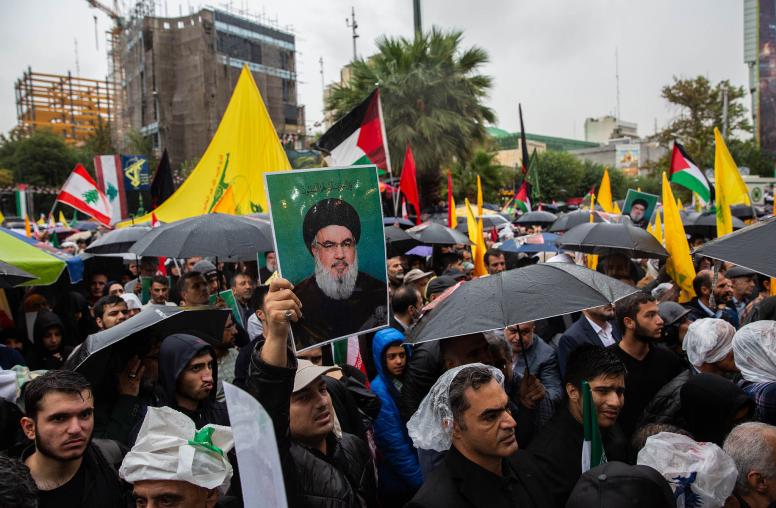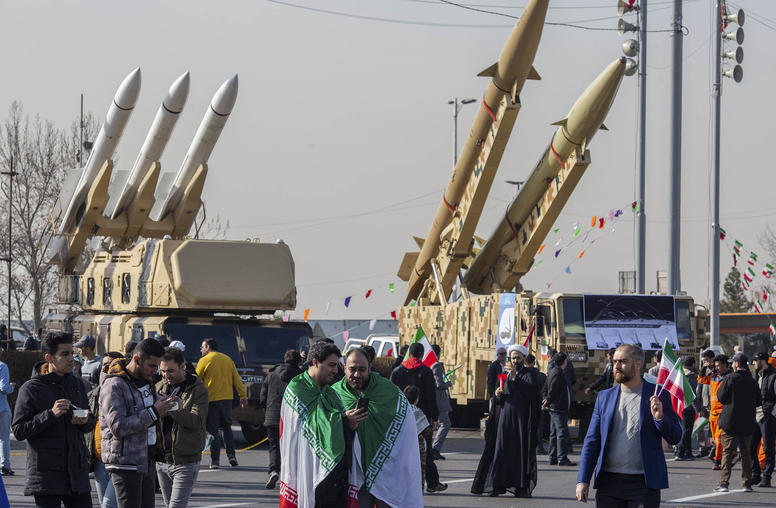Facing the Abyss: Lebanon's Deadly Political Stalemate
A protracted political stalemate plagues Lebanon. This dangerous deadlock has propelled the country once again toward the abyss of civil war. Will the violence that haunts the country's past recur? Is there a way out?

As the third anniversary of the assassination of former Lebanese Prime Minister Rafik Hariri approaches, Lebanon is witnessing its worst crisis since the 15-year civil war. Hariri’s February 14th assassination—widely suspected to have been orchestrated by Syria—enraged the Lebanese who took to the streets one month later, demanding the withdrawal of Syrian troops. Dubbed the Cedar Revolution, this mass protest movement succeeded in ending nearly 30 years of Syrian military occupation. It was to have ushered in a new era of democracy. Instead, Lebanon has suffered through bombings, assassinations, war between Hezbollah and Israel, and bouts of sectarian violence.
Today, Lebanon is plagued by a protracted political stalemate between a rump government led by the anti-Syrian March 14th coalition (inheritors of the Cedar Revolution) and the Hezbollah-led opposition. This dangerous deadlock has propelled Lebanon once again toward the abyss of civil war. Despite intensive Arab and European mediation efforts, a political compromise does not appear imminent.1 Rather, Lebanon seems poised to endure weeks, if not months, of continued paralysis and violence. This USIPeace Briefing examines some of the key issues underlying Lebanon’s current political turmoil.
Origins of the Impasse
The current impasse dates to November 2006, when Hezbollah, flush from its "victory" in its 34-day war with Israel, pulled its ministers from a coalition cabinet, demanding greater political power. In December 2006, the party mobilized its supporters to undertake widespread street demonstrations, calling for the toppling of Prime Minister Fuad Siniora’s March 14th coalition government.
Political infighting between the government and the opposition continued throughout 2007, with minimal progress toward compromise. If anything, the parties became more entrenched in their respective positions, amidst deepening suspicion and distrust. An assassination campaign mounted against anti-Syrian parliamentarians has forced forty MPs to seek safe haven in a Beirut luxury hotel since last autumn.2 The political deadlock grew more acute following the expiration of pro-Syrian President Emile Lahoud’s term in November 2007. The presidency has been vacant since Lahoud stepped down, with the Siniora government at loggerheads with the Hezbollah-led opposition over the terms surrounding the election of a new president. The Lebanese parliament has not met in more than a year, and the presidential vote has been postponed fourteen times. The next vote is scheduled for February 26, although a resolution to the crisis remains unlikely.
While the opposing factions appear to have agreed on army commander Michel Suleiman as a consensus presidential candidate, the crux of the crisis centers on Hezbollah’s insistent demands for veto power over government decisions. Specifically, the party is calling for control of one-third plus one of the cabinet seats (known as the "blocking third"), effectively serving as a potential veto on key policies that require two-thirds cabinet approval. While Hezbollah’s push for greater political influence taps into a longstanding sense of alienation and marginalization prevalent within the Shia community, its insistence on a veto undoubtedly is rooted in the armed movement’s desire to keep its weapons, despite numerous UN resolutions demanding that it disarm. As well, Hezbollah likely wants to protect its Syrian ally by obstructing movement on the UN-sponsored international tribunal established to prosecute those implicated in the Hariri assassination.
Violence Filling the Vacuum
Lebanon’s power vacuum has opened the way for a dangerous escalation in violence. Several developments over the past two months suggest the turmoil may be deepening. First, targets for assassination have expanded to include Lebanon’s security establishment. On December 12, 2007, Brigadier General Francois Hajj, army chief of operations, was killed by a car bomb. Hajj’s assassination marked the first attack on the Lebanese army, considered the most coherent and neutral government institution, occupying a space "above the fray." The following month, Captain Wissam Eid, a top terrorism investigator who had been working on the Hariri investigation as well as numerous other political killings, was killed in another car bomb attack. Taken together these two assassinations crossed a major "red line," signaling that even those charged with protecting the public were not immune from attack.

January 28, 2008 - Lebanese carry the coffins of protestors killed in rioting and clashes reminiscent of Lebanon's 15-year civil war in Beirut's southern suburbs. (AP Photo)
In an equally troubling development, a U.S. embassy vehicle traveling in a convoy was bombed in January; analysts speculate the attack could have been part of an assassination plot on the ambassador or another senior embassy officer. While no Americans were killed, the bombing represents the first attack on American interests in Lebanon since the 1980s. As the first attack on foreigners since the beginning of the current crisis, the attack crossed yet another threshold in the current spate of violence.
Finally, ongoing strikes and street demonstrations have sporadically erupted into more serious bouts of civil violence and rioting, often with sectarian undertones. In the most recent (and serious) episode, Shia demonstrators took to the streets in southern Beirut in January 2008 to protest continuing electricity cuts. Riots broke out after one of the protestors was shot under murky circumstances. Clashes spread to other parts of Beirut and at least seven people were killed in the ensuing violence. Perhaps most ominously, numerous reports over the past several months suggest that large numbers of Lebanese are arming themselves in the event such rioting spirals out of control, and the country descends into civil war.
To date, parties to the conflict have exercised some restraint, managing to rein in protestors when demonstrations deteriorate into violence. Leaders of both the March 14th coalition and the Hezbollah-led opposition have asserted repeatedly their desires to avoid civil war, which is not in either faction’s interest. Certainly, for everyday Lebanese, the memories of the 1975-1990 civil war serve as a strong disincentive toward violence. Nonetheless, in Lebanon’s dysfunctional political system, violence is often employed to serve political purposes. The anti-Syrian MP assassination campaign stands as one example. Indeed, Syria, in particular, is accused of perpetuating the violence to assert its influence following its forced military withdrawal. Hezbollah, for its part, often uses popular protests as a key tool to raise the pressure politically, encouraging strikes and exhorting its followers to take to the streets in demonstrations. Given Lebanon’s volatility, any miscalculation—or exploitation of the situation by shadowy forces that wish to ignite a civil war—could easily lead to violence spiraling out of control.
Stepping Back From the Brink
A short-term solution to the political crisis appears unlikely. Indeed, many analysts speculate that Lebanon’s stalemate will continue until 2009 when parliamentary elections are scheduled. Certainly, Hezbollah seems unlikely to budge from its insistence on veto power in the cabinet, calculating that it would likely gain seats in new parliamentary elections, thus strengthening its bargaining power. Moreover, the current deadlock could work to Hezbollah’s advantage by further weakening the presidency and other state institutions, enhancing the party’s appeal to its constituents as an alternative. Meanwhile, the March 14th coalition will continue to hold firm, mindful of the deep-seated implications of ceding veto power to Hezbollah, in what has become a zero-sum game for controlling Lebanon’s destiny.
At the core of this crisis lies the longstanding battle for Lebanon’s identity, an issue that arguably has dogged the country since its independence in 1943, if not its creation in 1920 following the break-up of the Ottoman Empire. A corollary, intertwining issue revolves around Lebanon’s ties to external actors—namely the United States and Europe on the one hand and Syria and Iran on the other. Each faction leverages its ties to external supporters to gain advantage in the domestic power struggle. At the same time, these outside players often fight their proxy battles via their allies in Lebanon.
Under these circumstances, arriving at a consensus solution is extraordinarily difficult, if not impossible. The key challenge is to walk both factions back from the brink and to restore some level of trust and confidence, rather than continuing to feed mounting dissension and fear. External agitation (particularly Syrian-inspired) and attempts to dissuade the factions from compromise must cease. Instead, mediation efforts should focus on disentangling foreign agendas from Lebanese internal questions and implementing confidence-building measures to help bridge the chasm between the conflicting parties and begin the long road toward a consensus.
Ultimately, two key issues must be addressed: first, the need to apportion political power to reflect the rising aspirations of the Shia community (considered to be the largest among Lebanon’s sects), while preserving Lebanon’s unique multi-confessional character.3 Second, to the extent possible, external issues must be de-linked from Lebanon’s internal complexities. Progress resolving key regional conflicts (Arab-Israeli, U.S.-Iran) that are often played out in Lebanon will be essential. While these goals may be distant ideals, working toward them will help to rescue Lebanon from its current turmoil and realize its potential as a stable, democratic model for the region.
Notes
1. In January 2008, the Arab League approved a three point plan which calls for the immediate election of Lebanese Armed Forces commander Michel Suleiman, the formation of a national unity government in which no party would have veto power, and the drafting of a new electoral law for the 2009 parliamentary elections. Arab League Secretary-General Amr Musa has engaged in intensive diplomacy, attempting to get the Lebanese government and the Hezbollah-led opposition to agree to the plan. The opposition remains opposed to the second point, insisting on veto power in the government.
2. Four anti-Syrian MPs have been assassinated since December 2005 in an attempt to eliminate the slim parliamentary majority held by the March 14th coalition.
3. Lebanon’s complex confessional system is made up of some 18 different religious sects. The last national census in Lebanon was undertaken in 1932. While estimates of the current confessional breakdown in Lebanon are difficult to assess, broader demographic trends suggest that the Muslim, particularly Shia, population has increased, while the Christian population continues to decline.
This USIPeace Briefing was written by Mona Yacoubian, special adviser to the Muslim World Initiative in the Center for Conflict Analysis and Prevention at the United States Institute of Peace and director of the Institute’s Lebanon Working Group. She would like to acknowledge Steven Heydemann for his helpful comments. The views expressed here are not necessarily those of USIP, which does not advocate specific policies.
The United States Institute of Peace is an independent, nonpartisan institution established and funded by Congress. Its goals are to help prevent and resolve violent international conflicts, promote post-conflict stability and development, and increase conflict management capacity, tools, and intellectual capital worldwide. The Institute does this by empowering others with knowledge, skills, and resources, as well as by directly engaging in peacebuilding efforts around the globe.



